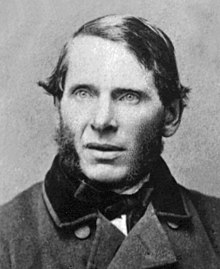Grímur Thomsen
Grímur Þorgrímsson Thomsen , known as Grímur Thomsen , (born May 15, 1820 on the farm Bessastaðir , Álftanes ; † November 27, 1896 ibid) was an Icelandic poet .
Life
Grímur Thomsen was the son of the goldsmith Þorgrímur Tómasson. From 1837 Grímur studied law , aesthetics , Hegelian philosophy and modern European literature at the University of Copenhagen . In 1843 he published a work on contemporary French poetry. In 1845 he received a master's degree with a thesis on Lord Byron . As a result, he was able to travel to the European capitals for two years on a royal scholarship. In 1854 Grímur Thomsen obtained his doctorate. phil. As an influential critic, he promoted the recognition of the works of Hans Christian Andersen , Johan Ludvig Runeberg and Bjarni Thorarensen in Denmark . Since Grímur represented Pan-Scandinavian views, he kept his distance from the Icelandic independence fighter Jón Sigurðsson . He maintained contacts with leading figures in Danish politics and worked in the Ministry of Foreign Affairs of Denmark from 1848 to 1866. He then returned to Iceland, married and bought the Bessastaðir farm, where he lived until his death. From 1869 to 1892 he was a member of the Icelandic parliament Althing .
plant
Although a poem by Grímur Thomsen appeared in the magazine Fjölnir in 1844 , he did not publish his first volume of poetry until 1880, at the age of sixty. During Grímur's lifetime only one further volume appeared (1895), further publications followed posthumously . His poems were not very popular at first, but grew in popularity over time. The literary scholar Stefán Einarsson names uncertainties in metrics as weaknesses of Grímur's poetry , although he was a master in style and expression. In the meantime, Grímur Thomsen is considered one of the most important poets in Iceland in the romantic tradition. Stefán Einarsson names the art ballads by Schiller , Goethe and Uhland as role models . Sigfús Blöndal wrote in the Encyclopædia Britannica in 1911 that Grímur Thomsen was the best ballad poet that Iceland had produced, and positively emphasized the unaffectedness of his poems. One of his best-known poems is the “ Sprengisandur song” Á Sprengisandi , which, when set by Sigvaldi Kaldalóns, has achieved the status of an Icelandic folk song .
Grímur Thomsen also worked as a translator. He translated from Old Icelandic into Danish and translated works by European poets into Icelandic. In his later years he devoted himself to translating ancient Greek poetry into Icelandic.
Web links
- Curriculum vitae on the homepage of the Icelandic Parliament Althing (Icelandic)
Individual evidence
- ↑ a b Grímur Thomsen - Æviágrip ( Icelandic ) Althingi. July 12, 2001. Retrieved April 30, 2015.
- ↑ a b c d e Stefán Einarsson: A history of Icelandic literature . Johns Hopkins Press, New York 1957, pp. 238 .
- ^ A b Stefán Einarsson: A history of Icelandic literature . Johns Hopkins Press, New York 1957, pp. 239 .
- ↑ Thomsen, Grímur . In: Encyclopædia Britannica . 11th edition. tape 26 : Submarine Mines - Tom-Tom . London 1911, p. 871 (English, full text [ Wikisource ]).
- ↑ Silja Aðalsteinsdóttir et al. (Ed.): Icelandic poetry . Insel, Berlin 2011, ISBN 978-3-458-35754-4 , pp. 220 .
| personal data | |
|---|---|
| SURNAME | Grímur Thomsen |
| ALTERNATIVE NAMES | Grímur Þorgrímsson Thomsen (full name) |
| BRIEF DESCRIPTION | Icelandic poet |
| DATE OF BIRTH | May 15, 1820 |
| PLACE OF BIRTH | Bessastaðir , Álftanes |
| DATE OF DEATH | November 27, 1896 |
| Place of death | Bessastaðir , Álftanes |
